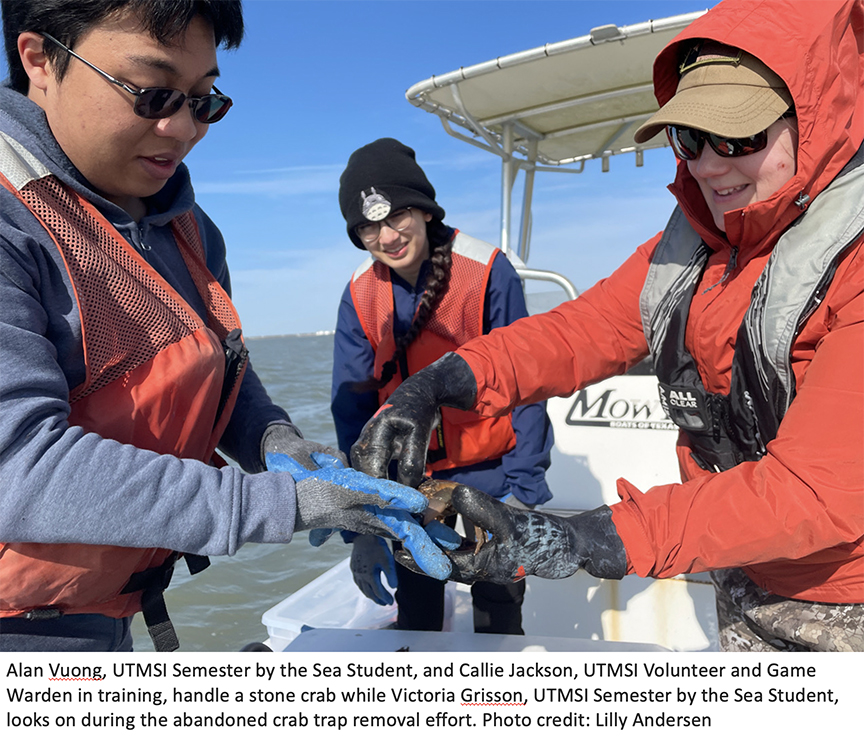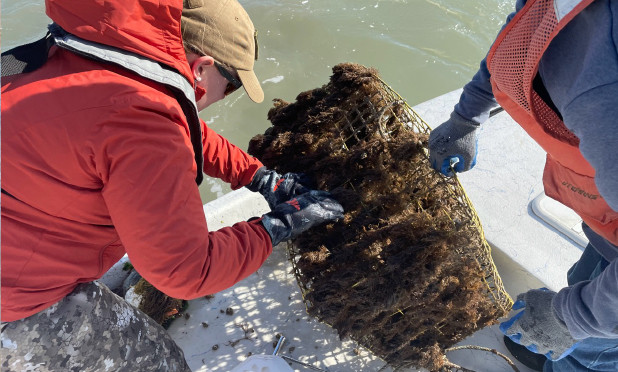Every February, the Texas Parks and Wildlife Department closes the bays to commercial and recreational crabbing for a 10-day period. This temporary closure enables a coordinated effort by agencies and organizations to remove derelict crab traps which continue to entrap and kill crabs, fish, and turtles.
“It’s especially important to remove these old traps from the bays. Not only are they a source of ghost fishing but also navigation hazards and unsightly litter,” said co-organizer Katie Swanson, Mission-Aransas Reserve Stewardship Coordinator at the University of Texas Marine Science Institute.
 This year, removing derelict crab traps was a massive effort involving 60 boat days and 148 volunteer days. The effort was led by San Antonio Bay Partnership (SABP), Mission-Aransas Reserve, the Lavaca Bay Foundation, and the Matagorda Bay Foundation who organized many groups, including U.S. Fish and Wildlife Service’s Aransas National Wildlife Refuge, Texas Parks and Wildlife Department Coastal Fisheries, local chapters of the Coastal Conservation Association, the Guadalupe Blanco River Trust, International Crane Foundation, Mid-Coast Texas Master Naturalists, Texas Sea Grant, Lavaca-Navidad River Authority, and individual citizen volunteers.
This year, removing derelict crab traps was a massive effort involving 60 boat days and 148 volunteer days. The effort was led by San Antonio Bay Partnership (SABP), Mission-Aransas Reserve, the Lavaca Bay Foundation, and the Matagorda Bay Foundation who organized many groups, including U.S. Fish and Wildlife Service’s Aransas National Wildlife Refuge, Texas Parks and Wildlife Department Coastal Fisheries, local chapters of the Coastal Conservation Association, the Guadalupe Blanco River Trust, International Crane Foundation, Mid-Coast Texas Master Naturalists, Texas Sea Grant, Lavaca-Navidad River Authority, and individual citizen volunteers.
This year, 1203 traps were removed from the three coastal bay systems on the Texas mid-coast (Lavaca/Matagorda, San Antonio, and Aransas Bays). The tally is significantly lower than last year’s count of 1632. Most of the derelict traps were found on the shoreline, likely due to storms. SABP Chairman Allan Berger anticipates that “the cause is due both to fewer boats/volunteers and the crabbers having done a better job of retrieving their traps.” The volunteers have started collecting data on the derelict traps and anticipate that an analysis of the data can reveal root-causes and result in fewer lost traps in the future.
This year’s derelict crab clean-up effort was supported with funds from a NOAA Marine Debris Program Community-based Marine Debris Removal grant obtained by the Coastal Bend Bays and Estuaries Program, supplemented by local sponsors Guadalupe Blanco River Trust, Guadalupe Blanco River Authority, and the San Antonio River. In addition, in-kind support was provided by U.S Fish and Wildlife Service, Texas Parks and Wildlife Department, Texas Sea Grant, Bay Flats Lodge, the Lavaca-Navidad River Authority, and the captains who provided their private boats.
Berger says that “While the cleanup is a lot of work, it is essential for keeping our bays clean and productive—and it’s fun.” If you want to be included in the early planning for next year, contact Allan Berger at This email address is being protected from spambots. You need JavaScript enabled to view it..

This post is modified from a press release from San Antonio Bay Partnership.









